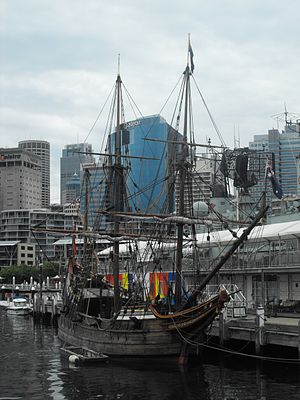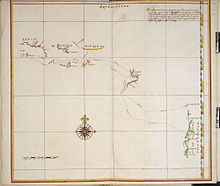- Duyfken
-

The reproduction of Duyfken on display at the Australian National Maritime MuseumCareer (Netherlands) 
Name: Duyfken Launched: 1595 Fate: Condemned beyond repair July 1608 at Ternate General characteristics Type: Barque Displacement: 110 tons Length: 65.4 ft (19.9 m) Beam: 19.7 ft (6.0 m) Draft: 8 ft (2.4 m) Propulsion: Sail Speed: 7 knots (13 km/h; 8.1 mph) Armament: 8 cannons Duyfken (also Duifken or Duijfken) ("little dove" in English, "duifje" in modern Dutch) was a small Dutch ship built in the Netherlands. She was a fast, lightly armed ship probably intended for shallow water, small valuable cargoes, bringing messages, sending provisions, or privateering.[1] The tonnage of Duyfken has been given as 25-30 lasten (50-60 tons).[2]
In 1606, during a voyage of discovery from Bantam (Banten), Java, captained by Willem Janszoon, she encountered the Australian mainland and Janszoon is thus credited with the first authenticated European discovery of Australia.
Contents
Voyages
In 1596, a ship named Duyfken sailed in the first expedition to Bantam, the crew was captured by the islanders on Pulau Enggano.[3] On 23 April 1601, Duyfken sailed from Texel as the jacht, or scout, under skipper Willem Cornelisz Schouten to the Spice Islands. After reaching Bantam, the "Moluccan Fleet", consisting of five ships including the Duyfken under admiral Wolphert Harmensz, encountered a blockading fleet of Portuguese ships totalling eight galleons and twenty-two galleys. They engaged this fleet in intermittent battle, driving them away on New Year's Day 1602. Thus, the undisputed dominance of the Iberians (Portuguese and Spanish) in the spice trade to Europe was ended.
The fleet received a warm welcome in Bantam, repairs were carried out to damage caused in the battle, and a survey of Jakarta Bay was undertaken, where the Dutch would later build Batavia, their capital in the Indies. Then, sailing by way of Tuban, East Java to the Spice Island of Ternate, cloves were loaded on board and the ship returned to Banda for a cargo of nutmeg.
The Duyfken was then sent on a voyage of exploration to the east when the newly formed United Dutch East India Company (VOC) was granted a monopoly on trade to the Spice Islands by the Dutch government. On the voyage home from the Indies the Duyfken was separated from the larger ships in a storm off Cape Agulhas, southern Africa and reached Flushing in April 1603,[2] two months ahead of the larger ships.
On 18 December 1603, the Duyfken, with Willem Janszoon as skipper, set out on a second voyage to the Indies in the VOC fleet of Steven van der Haghen. The VOC fleet captured a Portuguese ship in Mozambique Channel and sailed to the Spice Islands via Goa, Calicut, Pegu and finally reaching Bantam, Java on New Year's Eve 1604.
In 1605, the Duyfken was in the fleet that recaptured the fort of Van Verre at Ambon in the Spice Islands, from the Portuguese. She was then sent to Bantam, Java for urgently needed provisions.
In 1605, the Dutch East India Company (VOC) sent the Duyfken, captained by Willem Janszoon, to search for trade opportunities in the "south and east lands" beyond the furthest reaches of their known world. Willem Janszoon took the ship southeast from Banda to the Kei Islands, then along the south coast of New Guinea, skirting south of the shallow waters around False Cape (Irian Jaya) and then continuing east-southeast.
 A 1670 copy of an original map drawn on board the Duyfken during her voyage of discovery along the Australian coast in 1606 from the Atlas Van der Hem. The legend of the map states that 'This map shows the route taken by the pinnace Duifien on the outward as well as on the return voyage when she visited the countries east of Banda up to New Guinea'. Of most importance to Queenslanders is the fact that the map identifies the first landfall of the Duyfken on Australian soil as being at 11 degrees 45' S, the present day Pennefather River, where the map states 'R. met het Bosch'.
A 1670 copy of an original map drawn on board the Duyfken during her voyage of discovery along the Australian coast in 1606 from the Atlas Van der Hem. The legend of the map states that 'This map shows the route taken by the pinnace Duifien on the outward as well as on the return voyage when she visited the countries east of Banda up to New Guinea'. Of most importance to Queenslanders is the fact that the map identifies the first landfall of the Duyfken on Australian soil as being at 11 degrees 45' S, the present day Pennefather River, where the map states 'R. met het Bosch'.
In early 1606, Janszoon encountered and then charted the shores of Australia's Cape York Peninsula. The ship made landfall at the Pennefather River in the Gulf of Carpentaria. This was the first authenticated landing on Australian soil and for the first time all the inhabited continents of the world were known to the European science of geography. Janszoon is thus credited with the first authenticated European discovery of Australia. The ship sailed back to Bantam.
In 1607, the Duyfken may have made a second voyage east to Australia. Later in the year, she was sent to Java to get supplies for the beleaguered Dutch fortress on Ternate. In February or March 1608 the Duyfken was involved in hunting Chinese junks north of Ternate.[4]
In May 1608, the ship was engaged in a five hour battle with three Spanish galleys.[5] In June, she was sent with larger ships to capture the fortress of Taffaso on Makian Island. A month later, she was brought inside the reef at Ternate for repairs. It seems that she was hauled on her side to repair the bottom but this caused further damage, and the ship was condemned as beyond repair.
Duyfken Replica
A full size reproduction of the Duyfken was built by the "Duyfken 1606 Replica Foundation" jointly with the Maritime Museum of Western Australia and launched on 24 January 1999 in Fremantle. She then undertook goodwill tours to Sydney, Queensland, Indonesia, Sri Lanka, Mauritius, South Africa, and finally Texel in Netherlands. While in the Netherlands, the floor of the hold was replaced by antique Dutch bricks.
For a period in 2005, the Duyfken was berthed alongside the Old Swan Brewery on the Swan River in Perth, Western Australia. The replica was open for visits by the public.
In 2006, Western Australia played a big role in the 400th anniversary of the original Duyfken's visit to Australia and a national group has begun planning to commemorate the arrival of the Duyfken and to mark this important milestone in Australia's history by also giving recognition to all who followed her and contributed to the mapping of the Australian coast.
The Duyfken was berthed at the Queensland Maritime Museum in Southbank, Brisbane, Queensland until early 2011, when she was placed on display at the Australian National Maritime Museum in Sydney.
Notes
- ^ The first expedition to the Dutch Indies
- ^ a b Mutch, T. D. (1942). The First Discovery of Australia. Sydney: Mutch, Project Gutenberg of Australia. p. 14. http://gutenberg.net.au/ebooks06/0600631h.html.
- ^ Picture.
- ^ Opstall, M.E. van (1972), p. 311-312 De reis van de vloot van Pieter Willemsz Verhoeff naar Azië 1607-1612, deel 1. 's-Gravenhage: Martinus Nijhoff, 1972. (Werken uitgegeven door de Linschoten-Vereeniging; no. 73) ISBN 90-247-1287-4.
- ^ http://gutenberg.net.au/ebooks06/0600631h.html.
External links
- Duyfken website
- Duyfken visiting shipyard 'De Delft' (Delfshaven) in Rotterdam
- Duyfken Australia on the Map website
- [1]
Further reading
- Sent Forth a Dove: Discovery of the Duyfken. (1999) James Henderson. University of Western Australia Press. ISBN 1-876268-25-5.
Categories:- Exploration of Australia
- Exploration ships of the Netherlands
- Replica ships
- Ships of the Dutch East India Company
- 16th-century ships
Wikimedia Foundation. 2010.
